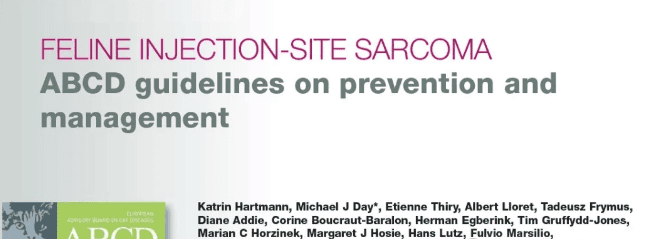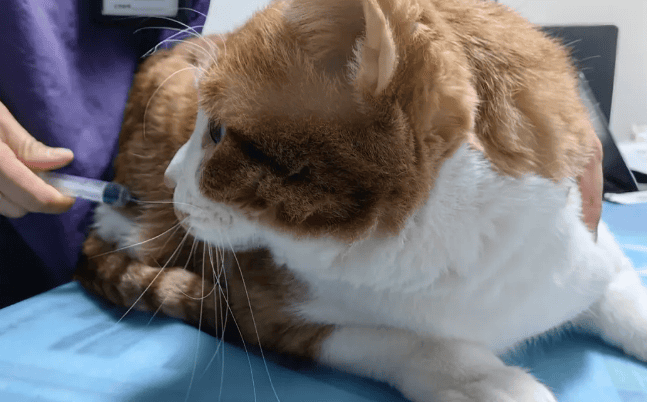In cats, the most serious adverse reaction after vaccination is the development of invasive sarcomas (mainly fibrosarcomas): so-called "feline injection site sarcomas" (FISSs). These lesions occur at the site of previous vaccinations or injections. It has different characteristics from fibrosarcoma in other locations and shows more aggressiveness. The transfer rate is 10 to 28%.
The pathogenesis of these sarcomas has not been clearly explained. However, a chronic inflammatory response is thought to be the trigger for subsequent malignant transformation.

Injection of long-acting drugs (such as corticosteroids) Hormones, etc.) are related to sarcoma formation.
Adjuvanted vaccines can induce strong local inflammation and therefore appear to be closely related to the occurrence of FISSs.
Modified live and recombinant vaccines carry lower risks, but no vaccine is risk-free.
In addition to vaccines, injectable drugs such as long-acting corticosteroids, penicillin, chlorfenuron, cisplatin, and meloxicam have also been associated with sarcoma development. One study found that cats with interscapular FISSs received significantly more frequent injections of long-acting glucocorticoids (dexamethasone, methylprednisolone, and triamcinolone acetonide) than control cats. Fibrosarcoma has also been reported at the site of deep nonabsorbable sutures in 1 cat; around an abdominal surgical swab in one cat; near the microchipping site in two cats; and in association with indwelling needles. This suggests that, in theory, all inflammatory responses have the potential to trigger uncontrolled proliferation of fibroblasts and myofibroblasts, leading to the development of FISSs, which in some cases may lead to malignant transformation.
Management
To avoid tumor recurrence, aggressive radical resection is required. The addition of radiotherapy and/or immunotherapy (such as recombinant feline IL-2) can improve the prognosis.
As a precaution, avoid using any irritating substances. Vaccinations should be given as often as necessary, but the less often the better.
The injection site should be chosen at a site where the surgery is likely to be completely cured; try to avoid the scapular area. Monitoring should be done after immunization.
Where are cats vaccinated?
01
The American Association of Feline Physicians (AAFP) Feline Vaccination Advisory Group provides recommendations for those practicing radiological (12), surgical (36), and medical (44) oncology. An informal survey was conducted among veterinarians to obtain their opinions on preferred vaccination sites. These experts agreed that the distal knee joint first, followed by the distal elbow joint, was their preferred site. The tail is also a popular injection site. Respondents frequently commented that the vaccine should be administered as low in the leg as possible.

02
Alternative recommendations have been made by the World Small Animal Veterinary Association's Vaccination Guidelines Group (VGG), which recognizes the practical difficulties veterinarians often face when trying to vaccinate the extremities or tail. The VGG recommendation is that the preferred site for vaccination (and possible surgical excision of FISSs) is the skin of the flanks. This is a well-tolerated surgery for most cats.
As a general recommendation, it is important to document the injection site in the patient's medical record. In addition, post-vaccination monitoring plays a vital role
How much do you know about post-vaccination monitoring (3-2-1 principle)
3 months after vaccination, the injection site Any lump that remains, is larger than 2 cm in diameter, or grows larger 1 month after vaccination should be surgically removed.
So should cats be vaccinated? What rules should be followed?
01
Science Technology
Long vaccination intervals should be used for adult animals; it is recommended to use booster vaccines with a validity period of 3 or even 4 years (such as Rabies vaccine and FPV vaccine).
Science Technology
Do not vaccinate cats that only live indoors with FeLV or rabies vaccines;
Do not vaccinate cats with antibodies.
02
Vaccination of cats provides necessary protection and should not be stopped because of the risk of feline injection site sarcomas (FISSs).
03
Vaccines are not the only injectable medical products related to FISSs.
04
It is important to develop an individual vaccination plan. According to current guidelines, cats should be regularly tested for antibodies and vaccinated if necessary.
Principles
1. Subcutaneous injection should be performed instead of intramuscular injection.
2. Unadjuvanted vaccines should be given priority; modified live vaccines or recombinant vaccines are better than inactivated vaccines; vaccines with long-term immunity should be given priority.
3. Cold vaccines are associated with a higher risk of FISSs, so the vaccine should be left at room temperature for 15 minutes before vaccination. But it should not be left without refrigeration for several hours.

 扫一扫微信交流
扫一扫微信交流
发布评论